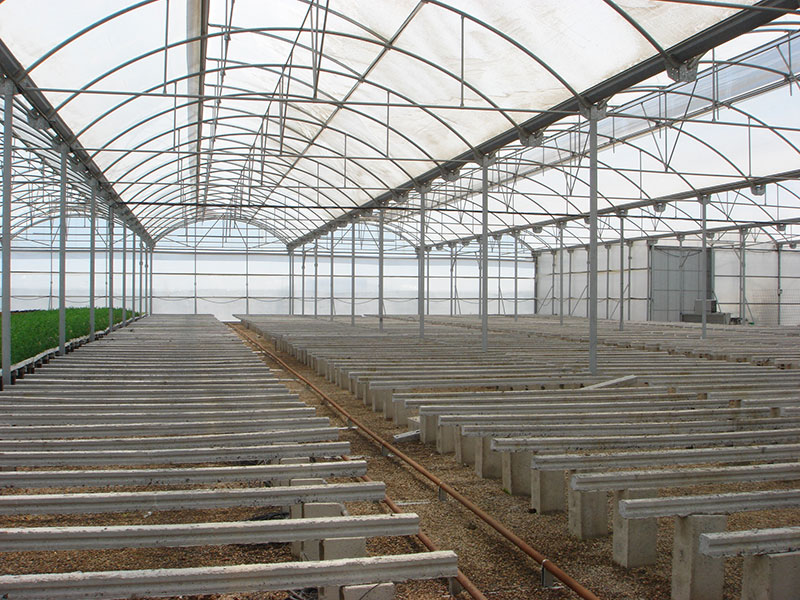Types of greenhouse structures in terms of application
Connected greenhouses
Twin greenhouses
Home greenhouses
Home greenhouses
Research greenhouses
Commercial greenhouses
Connected greenhouses
This greenhouse can be implemented without restrictions in different dimensions and heights. The side walls of these greenhouses, unlike tunnel or twin greenhouses, are vertical and are more expensive than tunnel greenhouses.
The advantages of these greenhouses include the following:
Consumption of less thermal energy than other greenhouses due to the low ratio of heat exchange surface (external surface) to the area under cultivation, higher volume of air available to the plant for photosynthesis (in winter) due to high ratio of air volume inside the greenhouse to the surface Cultivation slows down compared to other types of greenhouses. Ambient temperature fluctuations affect the temperature inside the greenhouse due to the low ratio of heat exchange surface (outside surface) to the volume of air inside the greenhouse and as a result better plant performance due to no thermal shocks. Surface coverage (even near walls) for a variety of plants The possibility of running a greenhouse with a high height (up to eight meters) to increase the volume of air available to the plant, to reduce to zero the impact of extreme temperature fluctuations on the plant or plant cultivation A height like a banana.
Minimal heat stress on plants in case of problems in one of the heating systems (for greenhouses that do not use the central heating system).
Twin greenhouses
These greenhouses are only twins and, like tunnel greenhouses, have arched walls on both sides, and it is not possible to use the surface under cover to cultivate more plants in the side areas. On the other hand, the price of these greenhouses is about interconnected greenhouses, and as can be seen in Figures A and B, in terms of the ratios of heat exchange to the area under cultivation, the volume of indoor air to the area under cultivation, and the level of heat exchange to the volume Indoor air is better than tunnel greenhouses. In general, it can be said that these greenhouses are something between tunnel and interconnected greenhouses in terms of advantages and disadvantages.
Home greenhouses
This type of greenhouse is small in size and for personal use at home and for growing ornamental plants or vegetables and is generally used in cold regions.
Tunnel greenhousesThese greenhouses are the simplest and cheapest variety of modern greenhouses with plastic cover, which are implemented in units with a cross section of a part of the circle (or similar). Cheapness, quick and easy installation, better control of the spread of diseases and pests from one unit to another units, receiving more light per unit area of the greenhouse due to the high ratio of external surface to the area under cultivation is one of the advantages of tunnel greenhouses and disadvantages. It can be mentioned as follows:
High energy consumption for heating in winter due to the high level of heat exchange (external surface) to the area under cultivation. Significant increase in indoor greenhouse temperature in summer due to the high ratio of surface to radiation (external surface) to the area under cultivation. Low volume of air available to the plant for photosynthesis (in winter) due to the low ratio of air volume in the greenhouse to the area under cultivation.
Rapid effect of ambient temperature fluctuations on the temperature inside the greenhouse due to the high ratio of heat exchange surface (outside surface) to the volume of indoor air and as a result of heat shock to plants and a negative impact on their performance inability to use the surface In the side parts for most plants (due to the arch of the structure on the sides) the possibility of frost of any greenhouse unit in case of problems in its heating system (for greenhouses that do not use the central heating system).
Research greenhouses
These greenhouses are generally used for research in the fields of agriculture, biology, genetics and ... which according to this article is equipped with a variety of environmental control systems such as light, temperature, humidity, CO2 and… as well as an automatic control system for these factors. And they are very expensive.
Commercial greenhouses
Commercial greenhouses are created with the aim of mass production of ornamental plants, vegetables, summer crops and fruits. The structure of these greenhouses is made of galvanized profiles or pipes and their cover is made of plastic, fiberglass, glass and.. Plastic or fiberglass greenhouses are generally lighter in structure and are very cheap compared to glass greenhouses and are mainly divided into three types of tunnels, twin and interconnected.

